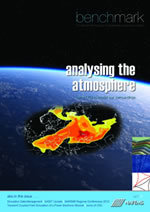benchmark april12
Analysing the atmosphere - Using CFD to model our surroundings

Stop. Stop what you’re doing for a second please. Go get a cup of coffee, tea, or your favourite tipple, and take 2 minutes to relax.
Is that better? Are you with me now? Good.
It’s one of the prevailing facts of modern life that we always try to do too many things at once.
It’s as if we’re trying to keep up with computers. They can multitask, right? So why can’t we? Why shouldn’t we do 10 things at once?
Because you’ll get one of them wrong. Guaranteed.
Apparently, mono-tasking is the next big thing. Concentrating on one task until completion, and then moving on to the next. You’re not a computer – you don’t have hyperthreading technology built-in. You haven’t suddenly had an upgrade to the latest and fastest chipset, enabling you to carry out more complex tasks than you could before. You’re the same person you were 10 years ago (probably with more likelihood of ‘bluescreening’ than you did back then too...). So, if like me you read editorials like this whilst replying to emails, organising your ‘to-do’ list, or driving (ok, not driving, but you get my point), perhaps it’s time to change the way you work, and in doing so, become more productive.
We all know the feeling of having multiple lists of things to do, juggling several projects at one time, and having to constantly re-prioritise your day until it becomes no more than a fire-fighting exercise. It’s just one of those things. But sometimes, it’s good to try something different, to try a new way of working or a new process to make your day, hell make your life better and more fulfilling.
Remember why you got into engineering? Our own CAE guy has discussed this in articles passim, but really – how often do you refer back to the very reasons you got into this business? Not very often, I’ll wager.
If we lose track of why we got into this industry, of what excited us or moved us to make this career choice, it makes it very difficult to work out how to encourage the ‘next generation’ of simulation engineers. At a recent internal meeting, we discussed how NAFEMS can help to encourage young students to view analysis and simulation as a viable, and exciting, career option. Yes, we all know that our work can be more than a little monotonous, but some of the projects we work on, some of the areas we specialise in, really are exciting. We need to harness that excitement, in order to bring new engineers into our community and continue to push the technology forward. Ok, perhaps kindergarten isn’t the right place to start promoting a career in engineering analysis, but you get my point – most young people don’t even know what analysis is, and at NAFEMS we see it as our role to promote not just the safe and reliable use of the technology, but the technology itself.
Within this issue, you’ll see a progress report on the EASIT2 project (www.easit2.eu), and an outline of plans to create a new recognised certification program for all those involved in analysis and simulation. It’s through initiatives like this that we can truly develop the role of the engineering analyst and/or ‘simulation engineer’, into a ‘visible’ career option with a professional accreditation program to ‘prove’ competency and track professional development.
It’s all about people – it’s all about you – and it’s all about the people who you will mentor and train to take the next steps in the future of simulation and analysis. So let’s, as a community, concentrate on one thing at a time, and look to develop our own ‘career ladder’ that those entering the profession can aspire to be part of.
You may now resume whatever you were doing. Thanks for your attention. :)
David Quinn I Editor I david.quinn@nafems.org I
twitter.com/benchtweet




